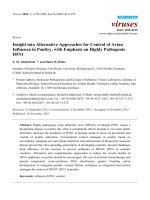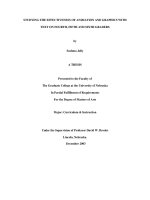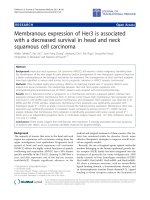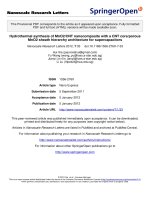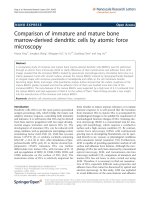Machining of High Strength Steels With Emphasis on Surface Integrity by air force machinability data center_4 pot
Bạn đang xem bản rút gọn của tài liệu. Xem và tải ngay bản đầy đủ của tài liệu tại đây (651.04 KB, 9 trang )
Figure 156. Vibration and chatter in machining operations, with their machine tool damping characteristics.
Chapter
is either ‘pearled’ , or ‘sh-scaled’) superimposed
over the normal cutting insert’s feed marks,
•
Visible surface undulations – these eects are re-
produced in the direction of feed, being the prod-
uct of either serrated, or wavy chip formations, of
variable thicknesses.
.. Chatter and Chip Formation –
Significant Factors Influencing
its Generation
e stability of the cutting process and the onset of re-
generative chatter is inuenced by a range of factors,
such as the: cutting stiness (K
s
)
29
of the workpiece
material – related to its machinability; parameters
of the machining process (e.g. speed, feed, D
OC
, chip
width – total); insert cutting geometry (e.g. rake and
clearance angles, edge preparation, insert shape and
size); cutting process dynamic characteristics (e.g.
machine-tooling-workpiece/xturing). Hence, during
machining operations on the workpiece, the chip is
formed by shearing over the chip area, producing the
cutting, or tangential force (F
T
). e magnitude of this
tangential force is heavily inuenced by the product
of the workpiece material’s stiness (K
s
) and the chip
area, as follows:
F
T
= K
s
× t × w
Where:
F
T
= tangential force (N),
K
s
= workpiece material’s stiness (N mm
–2
),
t = chip thickness (mm),
w = chip width (mm).
e direction of the tangential force (F
T
) is predomi-
nantly aected by the cutting insert’s rake and clear-
ance angles, together with the edge preparation on the
insert. In many single-/multi-point machining opera-
tions used to generate for example a milled surface,
there is a requirement to overlap the adjacent cutting
paths (Fig. 84c). For most single-point machining op-
29 ‘Cutting stiness’ (K
s
), is closely associated with that of ‘ow
stress’*, but is more simple to calculate and can be thought
of as a workpiece material property, being dependent on its
hardness.
*‘Flow stress’ , can be dened as: ‘e stress required to sustain
plastic deformation at a particular strain’ ( Kalpakjian, 1997).
erations, this former over-lapping of tool paths does
not take place in the same manner, but will only occur
aer one complete revolution of either the workpiece,
or tool. In operations by either milling (Fig. 85), or
drilling (Fig. 50), an overlap takes place in a fraction
of a revolution, this being dependent upon how many
cutting edges are present on the tool.
In the Degarmo, et al. (2003) machining model
shown in (Fig. 157a), the cutting or tangential force
(F
c
)
30
generation may cause a relative displacement ‘X’
between the cutting insert and the workpiece, aecting
the uncut chip thickness (t), this results in changing
the cutting force. is coupled relationship between
displacement in the ‘Y’ direction – modulation direc-
tion – and the resultant cutting force, creates a closed-
loop response system. Here, the modulation direction
is normally at 90° to the machined surface, so denes
the chip thickness. As a consequence of these inter-
related factors, there is a phase-shi (ε) between the
subsequent overlapping machined surfaces, resulting
in a variable chip thickness and modulation of the
displacement, causing chatter vibration to take place.
Accordingly, this phase-shi between overlapping cut-
ting paths is accountable for the production of chatter
(Fig. 157b). Moreover, there is a favoured speed cor-
responding to a phase-locked condition (e.g. when
‘ε=0’), resulting in a constant chip thickness (t). By
obtaining a constant chip thickness, this results in a
‘steady-state’ cutting force generation with it and, the
eradication of the feed-back mechanism for regenera-
tive chatter. In essence, this is the goal for all machin-
ing operators, as they attempt to achieve this eect by
vary the cutting speeds for a given set of conditions for
a particular machining operation.
.. Chatter – Important Factors
Affecting its Generation
In the previous sections, a brief discussion was made
concerning just some of the causes of regenerative
chatter mechanisms. It is worth looking in greater de-
tail at the reasons why this superuous chatter occurs,
explaining how and why it is generated in the hope of
30 In the Degarmo, et al. (2003) model diagrammatically shown
in Fig. 157a, they use the term and nomenclature of: ‘cutting
force’ and ‘F
c
’ , whereas previously in the text, this has been
referred to as the ‘tangential force’ , denoted by ‘F
T
’.
Machinability and Surface Integrity
Figure 157. A chatter model, with potential chatter conditions and the application of the ‘stability lobe
diagram’. [Source: Degarmo, Black & Kosher, 2003]
.
Chapter
either entirely eliminating it, or at the very least, min-
imising its aect on the overall machining process.
Chatter during machining can result from a range of
multifarious and oen linked-factors, they include:
•
Depth of cut (D
OC
) – can be considered as the prin-
cipal cause and, for the prospective control of chat-
ter. e D
OC
delineates the chip width, acting as
the feed-back gain
31
within the closed-loop cutting
process,
NB e machining processes ‘stability limit’ – be-
ing the threshold between stable cutting and chat-
ter – can be determined from trial-and-error by
simply incrementally increasing the D
OC
until the
commencement of chatter, then‘backing-o’ at this
level. e prediction of chatter’s onset can be found
analytically, this value being based upon thorough
knowledge of material stiness and cutting system
dynamics.
•
Rotational speed – is probably the simplest param-
eter to modify, thereby altering chatter and its as-
sociated amplitude,
NB e peripheral speed of either the rotating
tool, or workpiece, aects the phase-shi between
overlapping surfaces and its associated vibration
regeneration.
•
Feed – for milling operations the feed per tooth de-
nes the average uncut chip thickness (t), inuenc-
ing the magnitude of the cutting process. Chatter
is not unduly aected by the feedrate selected, but
feed does have an eect on the predictable severity
of vibration during machining,
NB As no cutting force exists if the vibration oc-
curs in the ‘Y’ direction – resulting in loss of con-
tact between the tool and workpiece – the maxi-
mum amplitude of chatter vibration will be limited
by its feed.
31 ‘Gain’ , can be practically dened in the following way: ‘e
ratio of the magnitude of the output of a system with respect
to that of the input – the conditions of operation and measure-
ments must be specied’ (Smith, 1993, et al.).
•
Cutting stiness (K
s
) – is a material property con-
nected to: shear ow stress; hardness, as well as
work-hardening characteristics of the workpiece,
this factor oen being referred to in a metaphorical
sense of its material’s machinability characteristics,
NB Materials that might oer poorer comparative
machinability, for example titanium, require con-
siderably higher cutting forces leading to a greater
displacement in the ‘Y’ direction and as such, oer
a less stable cutting action.
•
Width of chip (total) – is equivalent to the product
of the D
OC
multiplied by the number of cutting edges
engaged in the cut. Furthermore, the total cut width
will inuence the stability of the cutting process,
NB At a preset D
OC
corresponding to that of the
‘stability limit’ , increasing the number of engaged
cutting edges, will result in chatter, or vice-versa.
•
Cutting tool geometry – inuences both the direc-
tion and the magnitude of the cutting force, in
particular the quantity of the force component in
the modulation direction ‘Y’. So, an increased force
occurring in the ‘Y’ direction, causes amplied dis-
placement and vibration at 90° to the surface, creat-
ing ideal conditions for chatter. Other cutting insert
geometrical factors that can inuence the cutting
stability include the following:
–
Back rake angle (α) – as it is inclined to a more
positive angle, the length of the commencement
of the shearing zone decreases, this in turn, re-
duces the magnitude of the cutting force (F
c
). As
the back rake inclination becomes larger, then
this directs the cutting force in a more tangential
manner, thereby reducing the force component
in the ‘Y’ direction – creating improved stability
at higher speeds,
NB An insucient feedrate in comparison to the
insert edge radius produces a less ecient cutting
action, with more tool deection and reduced ma-
chining stability.
–
Clearance angle – reduction (γ) – has the eect
of increasing the frictional contact at the inter-
face between the tool and workpiece, possibly
having a process damping eect. is potential
stabilising eect could be the result of energy
Machinability and Surface Integrity
dissipation – heat transformation, which could
result in decreased tool life, with the superu-
ous eect of thermal distortion of the machined
part, or an increase in the workpiece’s heat-af-
fected zone (HAZ),
NB On a newly-tted cutting insert, if initial wear
occurs, this can sometimes have a stabilising eect
for the onset of chatter.
–
Nose radius – size, insert shape – diamond tri-
angular, square, round, plan approach angle
– positive, neutral, negative – all inuence the
area of the chip shape and its corresponding ‘Y’
direction. e orientation of the modulation
direction ‘Y’ toward a dynamically more-rigid
direction angle, allows a decrease in vibrational
response, giving greater overall process stability
– having notably less chattering tendencies.
As machining process stability is a direct result of
characteristics of dynamic force displacement between
both the workpiece and the cutting insert, all of the
various factors of a machining system: machine tool;
spindle; tooling; workpiece; workholding – in varying
degrees, can inuence chatter. To increase process sta-
bility of the machining system, it is necessary to maxi-
mise the dynamics, this being the overall product of its
static stiness and damping capacity. Further, machin-
ing stability can be increased by utilising tooling with
the greatest possible diameter with the minimum of
tool overhang. By way of a caution concerning chatter
frequency, this normally occurs near the most exible
vibrational mode of the machining system.
.. Stability Lobe Diagrams
In Fig. 157c, a ‘Stability lobe diagram’ (SLD) is de-
picted, which relates to the: total cut width that can be
machined, to the tooling’s rotational speed, for a speci-
ed number of cutting inserts. For example referring
to the: Degarmo, et al. (2003) diagram, suppose the
total width of cut was maintained below a minimum
level
32
, then the process stability would exhibit ‘speed
32 If the total cut width was maintained below a minimum level,
in practical terms this would be of limited value for many ma-
chining systems.
independence’ , or an ‘unconditional stability’. Hence,
at relatively slow speeds an increased stability can
be achieved within the process damping region – as
shown. e ‘conditional stability’ lobe regions of the
diagram, permit an increased total cut width (i.e the
D
OC
x number of cutting edges, these being engaged
in the cut) at dynamically preferred speeds, at which
the phase-shi ‘ε’ between overlapping, or consecutive
cutting paths approaches zero. In Fig. 157c, stability
lobe number ‘N’ refers to the complete vibration cycles
existing between overlapping surfaces. Moreover, the
higher speeds correspond to lower lobe numbers, pro-
viding the utmost potential increase in the total cut
width and material removal rate – this being due to
the greater lobe height and width. If the total cut width
exceeds the stability threshold – even assuming that
the cutting process is operating at the desired speed,
chatter will occur. So, the larger the total cut width
above the ‘stability limit’ , the more unstable and ag
-
gressive the chatter vibration becomes.
Referring to the diagrammatic representation of
the SLD on the graph in Fig. 157c, if a chatter con-
dition arises, such as that found at point ‘a’ , the ro-
tational speed is attuned to the initial recommended
speed (i.e. when ‘N=1’), resulting in stable machining
at point ‘b’ on this diagram. e D
OC
can be incremen-
tally increased until the onset of chatter again – as the
threshold stability is crossed at point ‘c’. By utilising a
hand-held ‘speed analyser’
33
whilst the chatter contin-
ues – under the previously-selected operating condi-
tions, this will result in the ‘analyser’ giving a modied
speed recommendation that corresponds to point ‘d’.
Now, if required, the D
OC
can be progressively incre-
33 ‘Speed analysers’ , are normally hand-held devices that pro-
duce dynamically-favoured speed recommendations and are
commercially available. Such ‘speed analyser’* equipment
when utilised for a cutting process, can show the relative mo-
tion between the tooling and the workpiece and recommends
the appropriate speed to avoid chatter-eects.
*‘Speed analysers’ can be successfully used for many industrial
applications, such as those involving: High-speed; in-chip,
hardened-die machining; multi-point cutting operations –
milling, etc.; Turning and boring operations. ese ‘speed anal-
ysers’ can also be employed for workpiece compositions rang-
ing from ductile metals (i.e. aluminium and steel grades) and
brittle materials (i.e. cast irons and brasses, etc.), together with
some non-metallics (plastics, etc.) and composite materials
(carbon bre, etc.).
Chapter
mentally increased to point ‘e’
34
– this being a ‘safe-
limit’ for the optimum machining operation.
7.4 Milled Roundness –
Interpolated Diameters
Circular features such as bosses, circular rebates, etc.,
can be CNC milled by utilising a specic word-ad-
dress ‘circular interpolation’
35
command. is CNC
function creates precise and accurate circular control
in two slideways simultaneously, while the milling
cutter mills around the workpiece, as depicted in Fig.
158. Here, the milling cutter’s rigidity plays an impor-
tant role in the quality of the nal machined feature,
this being based upon the ‘rigidity square rule’
36
. e
deected milling cutter illustrated in Fig. 158-right,
having lack-of-rigidity will produce some unwanted
eects on the nal milled part. Cutter deection not
only introduces the potential for chatter vibration,
but if used to mill up to square shoulder, its deection
distorts the component geometry and introduces har-
monic variation to the circular interpolated feature.
So that minimal change takes place in a milled prole,
it is advisable to keep to cutter lengths having short
34 Generally-speaking, it is not advisable to attempt to maintain
both the D
OC
and the total cut width at the stability thresh-
old , because any variation in the: workpiece aecting its cut-
ting stiness ‘K
s
’; speed errors; or perhaps small changes in
the overall dynamic characteristics of the machining system,
could result in crossing the stability limit, creating severe
chatter. For example, in a milling application, the amplitude
of chatter vibration can be limited by a provisional feed per
tooth reduction , until an established and desired speed has
been achieved oering a stable D
OC
.
35 ‘Circular interpolation’ , is a block of entered information di-
recting the CNC system to cut, either an arc, or a circle, (e.g.
G02 – in a clockwise, or G03 anti-clockwise direction).
36 ‘Rigidity square rule’ – for milling cutters states: ‘Cutter rigid-
ity decreases by the ‘square’* of the distance from the holder’
(Smith, 1993, et al.).
*For example, if a cutter ‘stood-out’ from its respective tool-
holder by 50 mm to mill a circular feature (Fig.158 – le), then,
if all other machining conditions remained the same and, then
cutter was replaced by one of 100 mm long (Fig. 158 – right),
it would now be 4 times less rigid, causing serious tool deec-
tion.
stand-o distances, conducive with correct and cur-
rent operational practices.
ere are several distinct problems involved in the
milling high-quality circular interpolated features and,
a slight digression into basic machine tool induced-er-
rors is necessary to clarify the circumstances for the
problems exhibited in Fig. 159. Most of today’s ma-
chine tools have what is termed ‘orthogonally-orien-
tated axes’
37
and in the case of the popular three-axis
vertical machining centre congurations, if the axes
have not been recently calibrated, then considerable
‘error’
38
can be introduced into the nal milled part
features. It has been well-proven that a machine tool
equipped with three orthogonal sideways: ‘X-axis’;
‘Y-axis’ – in the horizontal plane, together with the
‘Z-axis’ – in the vertical plane, can introduce up to 21
kinematic ‘errors’ into the cutting process. e kine-
matics for any machine tool are quite complex, when it
has the ability to provide motion to all its axes simulta-
neously, although these errors are oen small, they are
37 ‘Orthogonally-orientated axes’ , (is briey mentioned in Foot-
note 2) refers to the fact that each axis is positioned at 90° with
respect to each other, oen situated on top of another axis.
For example, on a typical 3-axis vertical machining centre,
the ‘Y-axis’ sits on top of the ‘X-axis’ , but at right-angles to it,
conversely, the ‘Z-axis’ is situated at 90° to these axes – hence
the term ‘orthogonal’.
NB Non-orthogonal machine tools exist, oen having com-
plex ‘kinematics’* between ve and six axes. erefore with
these machine tools, in order to machine (i.e. mill) a straight-
line. all the axes must be in synchronised control to achieve
this linear action.
*Kinematics, comes from the Greek word ‘Kinesis’ , which
means ‘Motion’. It can be dened as: ‘e study of motion with-
out regard for the cause‘ (Lombardi, 2001). In machine tool
terminology, it refers to the translational eects of both lin-
ear and angular motions. It is principally concerned with the
eects of the ‘degrees of freedom’ for a ‘free-body’ in three-di-
mensional space (also see: Footnote 47, in Chapter 3).
38 ‘Error’ is now not considered as an appropriate metrological
term for any form of calibration, the recommended term to-
day, is: ‘uncertainty’*.
*‘Uncertainty’ , has been simply dened as: ‘e doubt that
exists about the result of any measurement’ (Bell/NPL, 1999).
is is why today, uncertainty in measurement is a combina-
tion of many factors, some physical, while others are induced.
Hence, another term, along with all of these uncertainty fac-
tors has been coined, which is its ‘Uncertainty budget’ – this
being a simple mathematical calculation, based upon a sum-
mary of these uncertainty calculations.
Machinability and Surface Integrity
Figure 158. The eect of increased milling cutter length on the resultant circular interpolated prole on the workpiece.
Chapter
Figure 159. The generated errors produced when circular interpolating at high feedrates when high-speed machining.
Machinability and Surface Integrity
but signicant ‘errors’ , which can be said to be simplis-
tically produced as a result of:
•
Linear motions (six) – created by the displacement
of the forward-and-backward motion of the X-, Y-
and Z-axes slideway movements, introducing par-
ticular non-linearities into the slideway position-
ing,
•
Rotational motions (three) – yaw, pitch and roll for
each axis. All of these partial rotational motions can
be practically-described in the following manner:
•
Yaw is the side-to-side ‘crabbing-motion’ along the
slideway,
NB ‘Yaw’ is normally the result of too much clear-
ance (i.e. ‘slop’) in the adjacent slideway members.
•
Pitch introduces a backward-and-forward rock-
ing (pitching) action normal to the slideway, as the
moving element traverses along the axis,
NB ‘Pitching’ is probably due to the ‘prole/wavi-
ness’ (i.e. long-frequency eects) in its respective
slideway.
•
Roll is the clockwise-and-anticlockwise rotational
motion along the slideway.
NB ’Roll’ could be introduced by two ‘adjacent
ways’ situated on each slideway, but not being coin-
cident with respect to each other (i.e. laying in the
same respective plane), causing a limited pivoting
action – along the ‘line-of-sight’ of the axis as it tra-
verses along its length.
•
Squareness (three) – these ‘errors’ occur due to the
fact that each axis may not be at 90° (i.e. square) to
one another.
ese types of 21 ‘kinematic machine-induced er-
rors’ can be appreciably reduced by the application of
calibration through laser-based techniques. To a lesser
extent, these ‘errors’ can be minimised via ballbar ar-
tifact-based methods, oering a quick ‘health-check’
by either static, or dynamic assessment techniques.
e results of either the laser, or ballbar, can be fed
back into the machine’s CNC controller for dynamic
corrections as cutting takes place, oering a consid-
erable improvement in the machine’s subsequent ac-
curacy and precision. e above machine tool calibra-
tion techniques are somewhat beyond the scope of the
present discussion, the same could be said for ‘ther-
mally-induced errors’ , however, they can also inuence
the machined part surface and the machine tool’s pro-
ling abilities. Moreover, ‘error-mapping techniques’
and sophisticated in-process control by an associated
‘dynamic error compensation system’ , have been shown
to extensively reduce the eects of the ‘variety of er-
rors’ that can be present on the machine tool, but once
again, these topics are mentioned only for further re-
search applications – as necessary.
e circular interpolated milled prole shown in
Fig. 159, shows signicant departures from roundness
of the milled workpiece, which is a function of most of
the previously discussed kinematically- and thermally-
induced machine tool ‘errors’ , together with the possi
-
bility of some ‘load-induced errors’. is diagrammatic
representation (i.e. Fig. 159), indicates that several
‘errors’ on the milled circular interpolated prole are
present. At relatively slow simultaneous feeding-mo-
tions of the two axes (‘X-’ and ‘Y-axis’), it will generate
a reasonable facsimile of the required circular feature.
However, then by somewhat increasing this milled in-
terpolation speed, the apparent roundness will appre-
ciably degrade, the reasons for this degradation, might
be the result of:
•
Servo-spikes – these unwanted eects occur at the
‘axis transition points’
39
at their respective 90° angu-
lar intervals, oen termed ‘quadrant-points’ ,
•
Back-lash – possibly resulting from any form of
axis reversals, originating from the recirculating
ballscrews
40
, creating a slight ‘o-set’ , or ‘mismatch’
at the axis transition points,
•
Servo-errors – when both axes are simultaneously
moving, their respective linear speed should be
39 ‘Axis transition points’ , are where the ‘servo-spikes’ occur.
ey result from a reversal of one of the axes at this angular
position and, its associated motor power-surge creating this
‘spike’. Normally, the ‘spike’ is associated aerward by a cor-
responding, but very small localised slack here, as axis take-up
begins once more at these ‘quadrant-points’ on the circular-
interpolated feature (i.e. see the inset and magnied diagram
in Fig. 159).
40
‘Recirculating ballscrews’ , are not supposed to have any ap-
preciable back-lash present, as they are normally pre-stressed
by applying loads by the application of either: tension-, or
compression-shimming. However, as the pitch of any the screw
has minute errors present, these are usually ‘mapped-out’ by
the original machine tool builder – using the recognised In-
ternational Standard laser-calibration techniques. Although,
once the machine tool has been operating for sometime and
either local ballscrew-wear occurs, or perhaps the machine
has had the occasional ‘tool-crash’ , this can introduce and af-
fect both its pitching- and back-lash-errors.
Chapter
